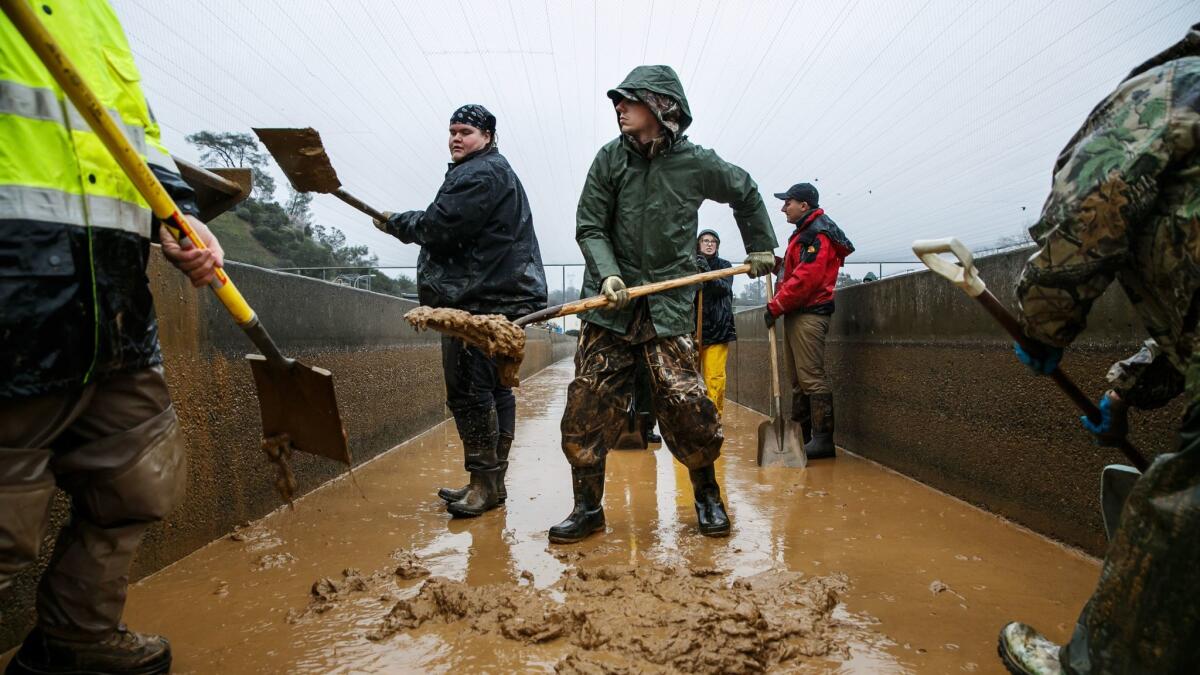Star-crossed salmon survive spillway erosion at Oroville Dam but suffocate after hatchery’s pump fails

- Share via
Reporting from Sacramento — A quarter-million hatchery salmon survived the near-collapse of the Oroville Dam’s emergency spillway this winter only to suffocate after a pump failed this week, officials said Thursday.
They were among about 5 million baby fall-run Chinook salmon that were rescued in February after tons of mud washed down the Feather River, said California Department of Fish and Wildlife spokesman Andrew Hughan.
The erosion came from the failing emergency spillway near the Oroville Dam that caused the precautionary evacuation of nearly 200,000 residents.
The salmon were trucked from the Oroville hatchery to a nearby annex fed by well water. An estimated 200,000 to 300,000 of the fish died Wednesday when a faulty wire caused a well pump to fail overnight, leaving the fish without enough fresh water and oxygen.
The fall-run salmon are not considered an endangered species, and the deaths are not expected to significantly affect the state’s salmon fishery.
“It’s just been a really rough year for that hatchery in particular. These fish have gone through a lot,” said Amanda Cranford, a natural resources specialist with the National Marine Fisheries Service.
They are among about 30 million fall-run salmon reared in Northern California each year in state and federal hatcheries.
John McManus, executive director of the Golden Gate Salmon Assn., lauded the department for rescuing the salmon in February and setting up what he called “an ingenious water filtration system” to save another 2 million fish left behind in the Oroville hatchery.
“We feel bad, partly because we’ve lost some fish, but also because the California Department of Fish and Wildlife just can’t catch a break this year,” said McManus, whose organization represents the sport fishing and commercial salmon industry.
The hatchery annex was never designed to hold so many fish long-term, and there were no auxiliary pumps or pump failure alarms, Hughan said. Nor were employees there overnight, unlike at the main hatchery, he said.
The annex had older wiring and equipment that had been operating continuously since the fish were transferred there three months ago, Hughan said.
“It was never designed to take on this kind of load, so it did an amazing job,” he said. “It saved the 5 million fish that never would have been able to survive if we hadn’t moved them over there.”
The department is now considering adding alarms and backup pumps and stationing employees at the annex around the clock.
The hatchery already released about 3 million salmon this spring. The surviving roughly 2 million fingerlings will be released into the Feather River over the next month when they reach about 8 inches long.
MORE ON THE OROVILLE DAM
The way California runs the Oroville Dam causes risk of flooding, area mayors say
Water under Oroville spillway probably caused February collapse, state consultants say
Serious design, construction and maintenance defects doomed Oroville Dam, report says
More to Read
Sign up for Essential California
The most important California stories and recommendations in your inbox every morning.
You may occasionally receive promotional content from the Los Angeles Times.













